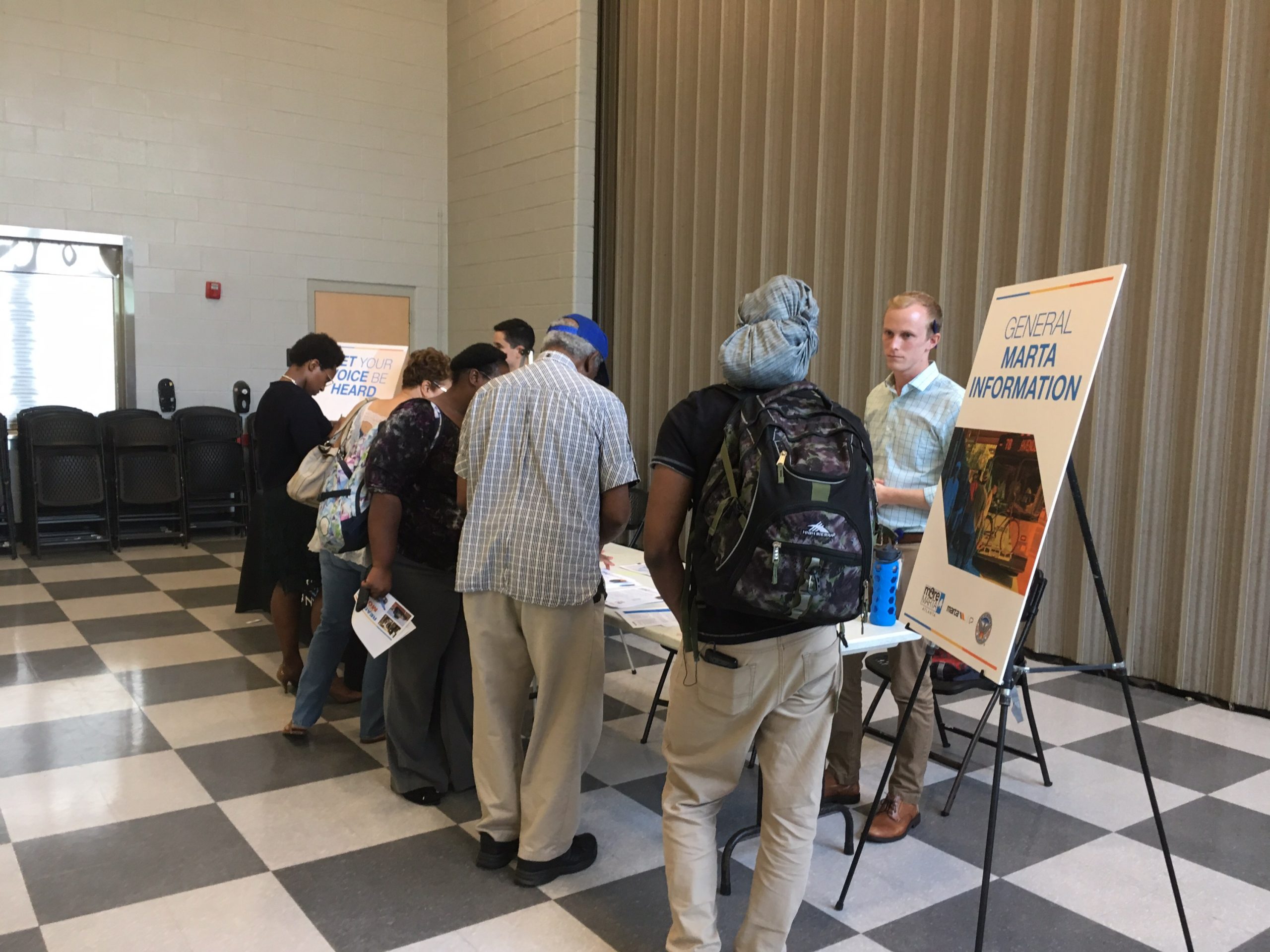
Atlanta City Council members Andrea L. Boone (District 10) and Michael Julian Bone (Post 1 At-Large) hosted More MARTA’s fourth, and final, community forum at the C.T. Martin Recreation Center.
Nearly all chairs were occupied, estimating around 50 seats.
MARTA will spend $2.5 billion over the next 40 years and the council, along with their represented districts, have iterated concerns at the forums and by survey.
“It’s still early, but we’ve [collected] about 2,300 surveys,” Ehren Bingaman, More MARTA’s deputy program manager, said. “Things we’ve heard: increased investment all over the BeltLine and [BeltLine] rail.”
According to earlier project proposition surveys, commuters’ opinions fail to sway.
During the forum, commuters urged immediate attention to basic detail.
“Can I get a clean bus?” a More MARTA forum attendee asked.
“[Commuters] consistently focus on more fixed transit like longer hours of operation, increased reliability, safety and cleanliness,” Bingaman said.
Bus rail transit (BRT) improvements have immediately gone into effect.
“We have 365 additional hours of service every day of the year on average moving forward, so that’s a lot of extra service we’re putting on the street,” Kyle Keahey, the More MARTA program manager, said. “That also means we have 80 new jobs we created associated with extra service.”
MARTA can expedite bus rail transit expansion, but focusing primarily on BRT could provide setbacks with new rail investment.
“It doesn’t take us long to implement BRT, build ridership and transition to light rail transit [LRT],” Keahey said. “But, the construction period, three or four years, disrupts the opportunity from the public and council members. We are rethinking that and making just one investment.”
Some attendees shared Keahey’s sentiment.
Joy Dixon, a MARTA commuter, said, “[There are] too many buses, and they’re not really servicing where they need to be.”
Southeast and northwest areas lack transit based on the current proposal.
“Southeast side folks want their needs met better [in addition to the] northwest side,” Bingaman said.
Lacking expansion in the southeast and northwest while providing transit to neighborhoods outside Atlanta confounded some attendees.
“We agreed to pay [the] sales tax. Two years ago, Emory [and the northside] was not a part of Atlanta. Does MARTA really think the people of Atlanta voted to pay transit to a section of a town that was not a part of Atlanta?” a More MARTA forum attendee asked.
In response, Keahey said, “It is more of a policy decision.”
Despite attendee concerns, Bingaman boasted “overwhelming support [for the expansion]: 70 percent.”
Yet, 70 percent approval begs the question: approval from whom?
“How can you estimate that [the proposal] will actually be serving people opposed to what we see on Auburn Avenue,” a More MARTA forum attendee said. “I think we’re going to have this very negative impact on [low-income] citizens because they’re not able to afford it .”
Large-scale, urban development projects typically result in higher land and housing costs, making it difficult for low-income citizens to sustain their living situation.
Gentrification has increased displacement of low-income residents, increasing their poverty in Old Fourth Ward and on Auburn Avenue, a historical African-American neighborhood.
Regarding gentrification, Keahey said, “We are expecting city policy to see where [economic] growth is going to occur.”
And the growth will outsize MARTA within five year.
The Atlanta-region Transit Link Authority (ATLtransit), the organization overseeing MARTA, the Atlanta streetcar, Gwinnett Xpress and all other metro Atlanta transit platforms will fold into The ATL by March of 2023.
The Atlanta Regional Commission’s (ARC) goal has been to increase mobility across county lines and other jurisdictions.
With The ATL lurking behind MARTA, some commuters questioned why they should focus on MARTA at all.
“My concern is that we are not focusing on the key mass transit power brokers,” Jonathon Williams, a More MARTA forum attendee, said. “So when we’re talking about $2.5 billion spread over [the years], The ATL is going to be overseeing MARTA, so we need to know who The ATL is, what their intentions are, which areas of governance they are going to oversee and what types of checks and balances exist for The ATL.”
On March 29, the Georgia General Assembly passed legislation that creates the funding framework for The ATL, a regional transit governing system for metro Atlanta’s entirety.
The ATL will plan transit across 13 metro counties, utilizing existing transit such as CobbLinc, Gwinnett County Transit, GRTA’s Xpress service and MARTA.
“We are privileged to learn what The ATL is going to be. It’s going to have an impact on how we do business at MARTA, as well as how we look at transit throughout the entire region,” Keahey said.
Doug Hooker, the ARC executive director, said, “The passage of regional transit legislation is a major milestone for our region that will expand transportation options and better connect communities, improving quality of life for metro Atlanta residents … The establishment of a coordinated, regional transit network is critical to the region’s future and will help ensure our long-term economic competitiveness.”
Though, the ARC’s lack of community outreach creates skepticism among some commuters.
“We need the ARC to be visible, transparent, accountable and doing what [MARTA] is doing, being articulate. And not having MARTA do the hard work while the [ARC] has all their meetings in the shadows,” Williams said.
The ARC has not held forums alongside More MARTA, but Keahey said, “We are very well integrated with the ARC, so they are involved with the process.”
The ARC will oversee metro Atlanta’s long-term transportation plan.
“We’re chasing MARTA, but not chasing The ATL while they make huge decisions. We think it’s all in MARTA’s hands and it’s not,” Williams said.
The 16-member board for The ATL will be named by Dec. 1 and will serve a four-year term.
